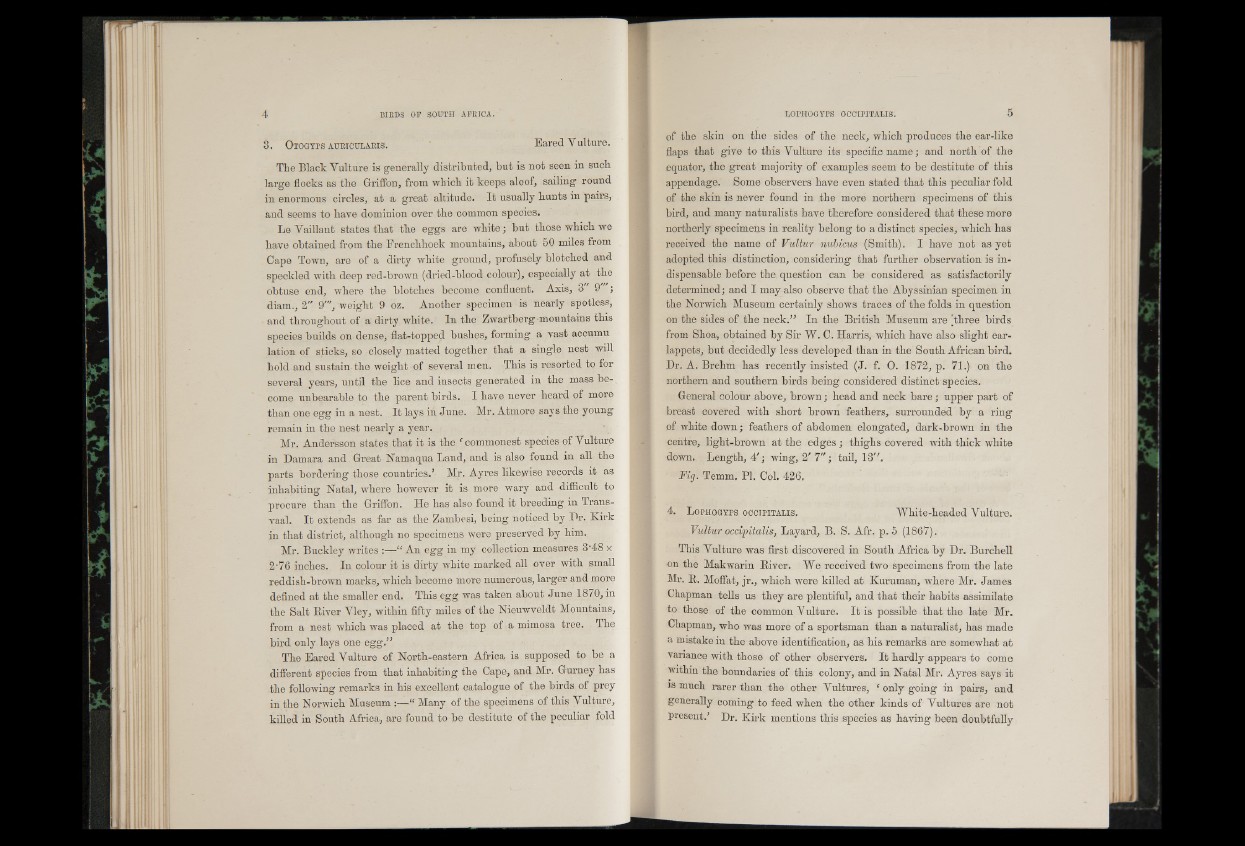
3. O togyrs aurtcularis. ' Bared Vulture.
The Black Vulture is generally distributed, but is not seen in such
large flocks as the Griffon, from which it keeps aloof, sailing round
in enormous circles, at a great altitude. It usually hunts in pairs,
and seems to have dominion over the common species.
Le Vaillant states that the eggs are white; but those which we
have obtained from the Brenchhoek mountains, about 50 miles from
Cape Town, are of a dirty white ground, profusely blotched and
speckled with deep red-brown (dried-blood colour), especially at the
obtuse end, where the blotches become confluent. Axis, 3 9 ;
diam., 2" 9"', weight 9 oz. Another specimen is nearly spotless,
and throughout of a dirty white. In the Zwartberg-mountains this
species builds on dense, flat-topped bushes, forming a vast accumu
lation of sticks, so closely matted together that a single nest will
hold and sustain the weight of several men. This is resorted to for
several years, until the lice and insects generated in the mass become
unbearable to the parent birds. I have never heard of more
than one egg in a nest. It lays in June. Mr. Atmore says the young
remain in the nest nearly a year.
Mr. Andersson states that it is the ‘ commonest species of Vulture
in Damara and Great Nam aqua Land, and is also found in all the
parts bordering those countries.5 Mr. Ayres likewise records it as
inhabiting Natal, where however it is more wary and difficult to
procure than the Griffon. He has also found it breeding in Transvaal.
It extends as far as the Zambesi, being noticed by Hr. Kirk
in that district, although no specimens were preserved by him.
Mr. Buckley writes :—“ An egg in my collection measures 3‘48 x
2-76 inches. In colour it is dirty white marked all over with small
reddish-brown marks, which become more numerous, larger and more
defined at the smaller end. This egg was taken about June 1870, in
the Salt River Vley, within fifty miles of the Nieuwveldt Mountains,
from a nest which was placed at the top of a mimosa tree. The
bird only lays one egg.55
The Eared Vulture of North-eastern Africa is supposed to be a
different species from that inhabiting the Cape, and Mr. Gurney has
the following remarks in his excellent catalogue of the birds of prey
in the Norwich Museum :—“ Many of the specimens of this Vulture,
killed in South Africa, are found to be destitute of the peculiar fold
of the skin on the sides of the neck, which produces the ear-like
flaps that give to this Vulture its specific name; and north of the
equator, the great majority of examples seem to be destitute of this
appendage. Some observers have even stated that this peculiar fold
of the skin is never found in the more northern specimens of this
bird, and many naturalists have therefore considered that these more
northerly specimens in reality belong to a distinct species, which has
received the name of Vultur nubicus (Smith). I have not as yet
adopted this distinction, considering that further observation is indispensable
before the. question can be considered as satisfactorily
determined; and I may also observe that the Abyssinian specimen in
the Norwich Museum certainly shows traces of the folds in question
on the sides of the neck.55 In the British Museum are (three birds
from Shoa, obtained by Sir W. C. Harris, which have also slight ear-
lappets, but decidedly less developed than in the South African bird.
Dr. A. Brehm has recently insisted (J. f. 0. 187-2, p. 71.) on the
northern and southern birds being considered distinct species.
General colour above, brown; head and neck bare; upper part of
breast covered with short brown feathers, surrounded by a ring
of white down; feathers of abdomen elongated, dark-brown in the
centre, light-brown at the edges; thighs covered with thick white
down. Length, 4'; wing, 2' 7"; tail, 13''.
Fig. Temm. PI. Col. 426.
4. L ophogyps o ccipital is . White-headed Vulture.
Vultur occipitalis, Layard, B. S. Afr. p. 5 (1867).
This Vulture was first discovered in South Africa by Dr. Burchell
on the Makwarin River. We received two specimens from the late
Mr. R. Moffat, jr., which were killed at Kuruman, where Mr. James
Chapman tells us they are plentiful, and that their habits assimilate
to those of the common Vulture. It is possible that the late Mr.
Chapman, who was more of a sportsman than a naturalist, has made
a mistake in the above identification, as his remarks are somewhat at
variance with those of other observers. It hardly appears to come
within the boundaries of this colony, and in Natal Mr. Ayres says it
is much rarer than the other Vultures, ‘ only going in pairs, and
generally coming to feed when the other kinds of Vultures are not
present.5 Dr. Kirk mentions this species as having been doubtfully